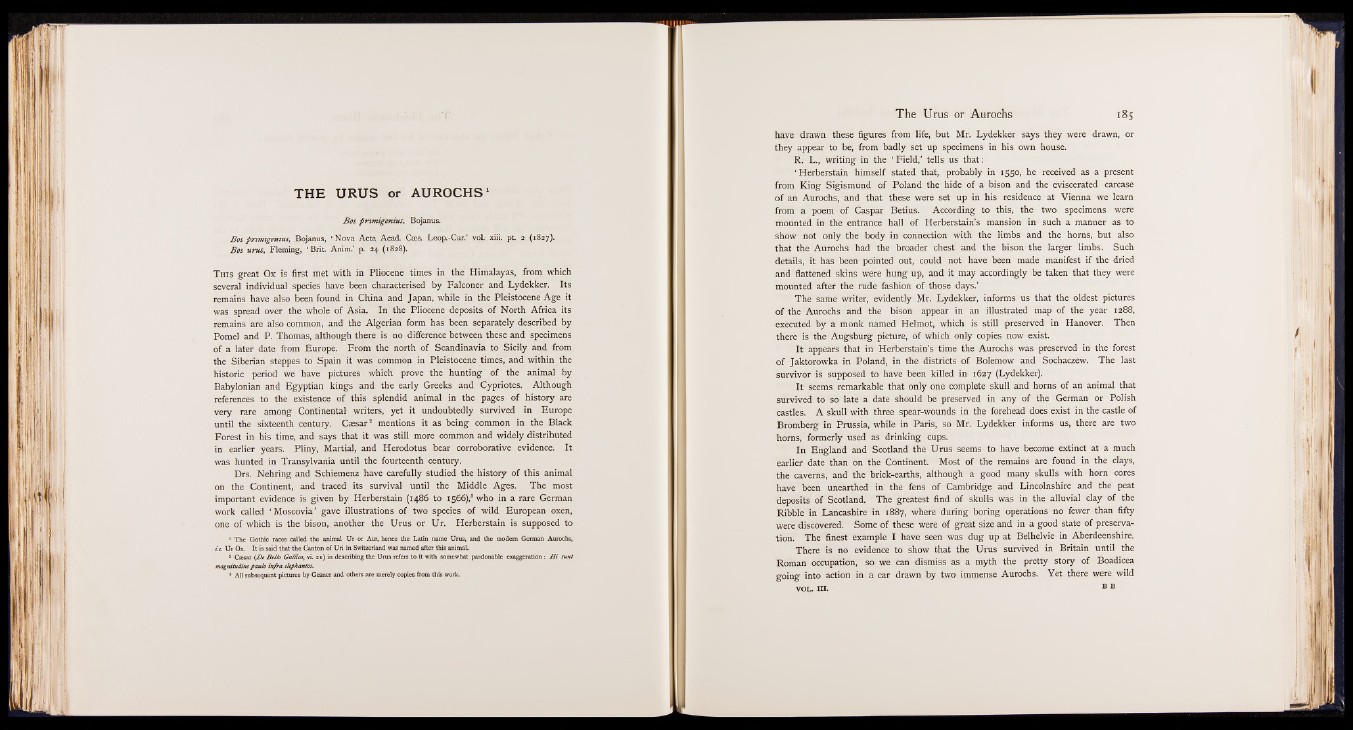
THE URUS or AUROCHS
B os pnm ig en in s, Bojanus.
B os pnm igenius, Bojanus, ‘ Nova Acta Acad. C»s. Leop.-Car.’ vol. xiii. p t 2 (1827).
Bos urus, Fleming, ‘ Brit. Anim.’ p. 24 (1828).
T h i s great Ox is first met with in Pliocene times in the Himalayas, from which
several individual species have been characterised by Falconer and Lydekker. Its
remains have also been found in China and Japan, while in the Pleistocene Age it
was spread over the whole of Asia. In the Pliocene deposits of North Africa its
remains are also common, and the Algerian form has been separately described by
Pomel and P. Thomas, although there is no difference between these and specimens
of a later date from Europe. From the north of Scandinavia to Sicily and from
the Siberian steppes to Spain it was common in Pleistocene times, and within the
historic period we have pictures which prove the hunting of the animal by
Babylonian and Egyptian kings and the early Greeks and Cypriotes. Although
references to the existence of this splendid animal in the pages of history are
very rare among Continental writers, yet it undoubtedly survived in Europe
until the sixteenth century. Caesar2 mentions it as being common in the Black
Forest in his time, and says that it was still more common and widely distributed
in earlier years. Pliny, Martial, and Herodotus bear corroborative evidence. It
was hunted in Transylvania until the fourteenth century.
Drs. Nehring and Schiemenz have carefully studied the history of this animal
on the Continent, and traced its survival until the Middle Ages. The most
important evidence is given by Herberstain (i486 to 1566),8 who in a rare German
work called ‘ Moscovia ’ gave illustrations of two species of wild European oxen,
one of which is the bison, another the Urus or Ur. Herberstain is supposed to
1 The Gothic races called the animal Ur or Aur, hence the Latin name Urus, and the modem German Aurochs,
i.e. Ur Ox. It is said that the Canton of Uri in Switzerland was named after this animal.
s Caesar (He Bello Gallico, vi. 21) in describing the Urus refers to it with somewhat pardonable exaggeration : H i sunt
magnitudine paulo infra elephantos.
3 All subsequent pictures by Gesner and others are merely copies from this work.
have drawn these figures from life, but Mr. Lydekker says they were drawn, or
they appear to be, from badly set up specimens in his own house.
R. L., writing in the ‘ Field,’ tells us that:
‘ Herberstain himself stated that, probably in 1550, he received as a present
from King Sigismund of Poland the hide of a bison and the eviscerated carcase
of an Aurochs, and that these were set up in his residence at Vienna we learn
from a poem of Caspar Betius. According to this, the two specimens were
mounted in the entrance hall of Herberstain’s mansion in such a manner as to
show not only the body in connection with the limbs and the horns, but also
that the Aurochs had the broader chest and the bison the larger limbs. Such
details, it has been pointed out, could not have been made manifest if the dried
and flattened skins were hung up, and it may accordingly be taken that they were
mounted after the rude fashion of those days.’
The same writer, evidently Mr. Lydekker, informs us that the oldest pictures
of the Aurochs and the bison appear in an illustrated map of the year 1288,
executed by a monk named Helmot, which is still preserved in Hanover. Then
there is the Augsburg picture, of which only copies now exist.
It appears that in Herberstain’s time the Aurochs was preserved in the forest
of Jaktorowka in Poland, in the districts of Bolemow and Sochaczew. The last
survivor is supposed to have been killed in 1627 (Lydekker).
It seems remarkable that only one complete skull and horns of an animal that
survived to so late a date should be preserved in any of the German or Polish
castles. A skull with three spear-wounds in the forehead does exist in the castle of
Bromberg in Prussia, while in Paris, so Mr. Lydekker informs us, there are two
horns, formerly used as drinking cups.
In England and Scotland the Urus seems to have become extinct at a much
earlier date than on the Continent. Most of the remains are found in the clays,
the caverns, and the brick-earths, although a good many skulls with horn cores
have been unearthed in the fens of Cambridge and Lincolnshire and the peat
deposits of Scotland. The greatest find of skulls was in the alluvial clay of the
Ribble in Lancashire in 1887, where during boring operations no fewer than fifty
were discovered. Some of these were of great size and in a good state of preservation.
The finest example I have seen was dug up at Belhelvie in Aberdeenshire.
There is no evidence to show that the Urus survived in Britain until the
Roman occupation, so we can dismiss as a myth the pretty story of Boadicea
going into action in a car drawn by two immense Aurochs. Yet there were wild
v o l . h i . B B